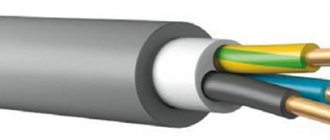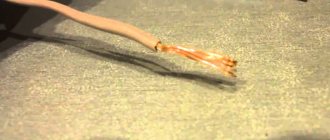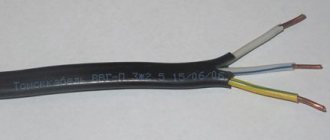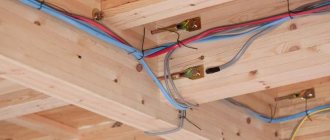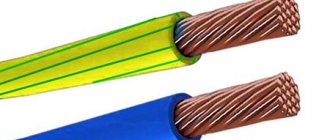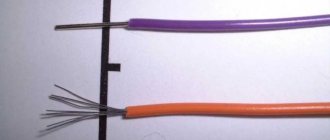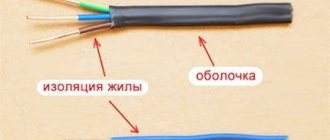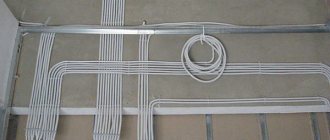When installing electrical wiring in an apartment, as well as when connecting individual consumers to the electrical network, the question often arises, which is better - stranded or single-core wire? It is impossible to clearly prefer one option or another. Each of these types of electrical wires has its own advantages and disadvantages, each is better suited for certain installation and operating conditions. Therefore, it is important to understand in detail which wiring is better - multi-core or single-core for specific cases.
Advantages and disadvantages
When the functional cores are assembled under a single sheath, such a wire is more convenient to lay, especially in hard-to-reach trays and cable channels. Its shell protects all the cores at the same time, i.e. there is a clear saving in labor costs and in the consumption of insulation material. But there is one scourge of all multi-core wires - this is capillarity, i.e. drawing in moisture from the cut end through the cavities between the insulated conductors. For this purpose, the cavities are filled with rubber or similar non-flammable fillers.
Stranded and single-core cables
Single-core soft copper wires, for example, are widely used in the automotive industry, where the role of the “minus” is played by the car body itself, when distributing electrical wiring in rooms, assembling lighting panels and distribution cabinets, and acoustics.
Single-core copper wires are indispensable in electrical wiring to sockets and lighting fixtures. Every electrician is familiar with the procedure when, in the absence of a standard wire, he is forced to unravel a multi-core cable with a knife, removing individual insulated cores from there to perform the tasks of wiring groups of sockets.
Important! The insulation and copper conductor of a single-core wire must withstand repeated kinks when seating the outlet module in place
What is wire cross-section and how to determine it
To see the cross-section of the wire, just cut it across and look at the cut from the end.
The cut area is the cross-section of the wire. The larger it is, the more current the wire can transmit.
As can be seen from the formula, the cross-section of the wire is light according to its diameter. It is enough to multiply the diameter of the wire core by itself and by 0.785. For the cross-section of a stranded wire, you need to calculate the cross-section of one core and multiply by their number.
The diameter of the conductor can be determined using a caliper with an accuracy of 0.1 mm or an accuracy of 0.01 mm. If you don’t have any instruments at hand, then this will help out.
What is a wire or cable made of?
As you know, wire and cable are different products, but for the purposes of this article we will not pay attention to this. Any conductor consists of a current-carrying core, which can be bare or covered with one- or two-layer insulation
The latter is made from dielectrics, which include polyvinyl chloride, rubber, fluoroplastic and polyethylene. There are more specific insulating materials that add various properties to the wire (for example, allowing the product to be immersed in water to a certain depth). The cores are made of aluminum or copper. The latter metal is considered more modern and reliable.
The veins may differ in structure:
- Single-wire ones are more rigid. They consist of one cylindrical/sectoral rod. Often single-wire ones are called monolithic.
- Stranded conductors are characterized by increased flexibility (softness). Their design involves the use of seven or more thin wires. The exact number of wires depends on the specific model of cable products and is prescribed in technical specifications or GOST. Basically, the number of wires is selected depending on the required cross-section or flexibility class.
Important. The terms single-wire and multi-wire refer to conductors
In this case, confusion arises with the names single-core and multi-core, when it becomes unclear what we are talking about: the number of current-carrying cores in the cable or the number of wires in one conductor. It is important to clarify this point.
Monocore or multicore
The service life of a soft wire such as PVA or similar is less than that of a single-core wire such as VVG or Num, not because they have worse insulation, but purely because of their purpose. The essence of this misconception is that a flexible wire (for example, PVA) is intended for connecting electrical appliances using a flexible cord, that is, it makes it possible to move the connected device without any special restrictions and do this many times without the risk of breaking the conductor. A cable with a monocore cannot provide such flexibility as PVA; moreover, it will simply break due to frequent kinks, so such a cable (with a monocore) cannot be used, for example, to connect an iron.
What does an electrical wire consist of?
Any wire has an electrically conductive core - bare or insulated. The insulation can be rubber, polyethylene, fluoroplastic, PVC or other material with dielectric properties. The conductors themselves are either aluminum or copper.
According to their structure, wires are also divided into two large groups:
- Rigid single-wire. The conductor is solid (monolithic), shaped or cylindrical.
- Soft multi-wire. Includes 7 or more wires.
The required number of wires is determined by GOST 22483/2012. It varies depending on the size of the cross-section and the degree of flexibility of the core.
Application
Single-core cables are used for trunk and horizontal cable routes. This is due to good electrical performance and stable high frequency. Long cables can be laid in walls, through ceilings, or to connect work areas within the same floor. However, please note that these cables should not be bent or twisted repeatedly as this may damage them.
Stranded cables are used for short runs between network interface cards and wall plates, or between hubs and patch panels or other rack-mounted equipment, because they will be constantly plugged in and out of flex. When you use multicore cables of a certain category, be sure to limit their length to reduce insertion loss.
Choosing between single-core and stranded wire
To determine which is better: stranded wire or solid wire, it is important to evaluate the advantages of each type, taking into account the resistance to electric current transmission. The main advantage of single-core cables is their low resistance rating, designed for 1000 linear meters
For example, this parameter for a copper conductor with a diameter of 1 mm should be 18.1 Ohms. A class 5 wire may have a resistance higher by 1.4 ohms, which is within the permissible error
The main advantage of single-core cables is their low resistance rating, designed for 1000 linear meters. For example, this parameter for a copper conductor with a diameter of 1 mm should be 18.1 Ohms. A class 5 wire may have a resistance higher by 1.4 ohms, which is within the permissible error.
This deviation is explained by the fact that as the cross-sectional diameter of a single fiber decreases, the resistance increases. Even when many single fibers are combined into a single whole, a total deviation is observed.
The main differences between single-core and multi-core cables are the method and ease of installation. The manual for electrical installation rules (PUE) provides for the following types of connections:
- screw;
- clamping;
- welding;
- pressing;
- soldered.
Single-wire and multi-wire cables can be connected using various materials, the choice of which depends on the diameter and number of metal fibers. For example, it is better to make a connection using screw terminals for a single-core wire.
Watch this video on YouTubeIn this case, the screws will not pinch the conductor, and the individual fibers will be firmly fixed at the point of contact connection. It is easier to connect a wire to 1 fiber, but this does not mean that you cannot weld a multi-core cable.
It is important to consider: high-grade conductors can be damaged during welding, which will negatively affect the quality of the connection. Pressing is carried out using a special tool
This method can be used for any type of wire. Materials with a small fiber cross-section are allowed to be soldered.
To determine which copper wire is better: stranded or single-core when laying communications, you need to assess the availability of space for installation. If the cable needs to be bent strongly during installation, it is easier to use a material with a large number of fibers.
Common multi-core cable products
Solid or stranded wire: wire flexibility classes
The choice of products with multiple channels is wider.
- PPV is a flat rigid wire with 2-3 copper cores. Twin-core varieties are used for simple lighting circuits and electrical wiring in a single-phase system. Garages and cottages are equipped with such wires, but they are not suitable for three-phase networks. Three-core PPV is suitable for complex lighting schemes. According to regulations, it is only allowed to be laid permanently in trays, boxes, cable ducts, and protective corrugated pipes.
- VVG is a round flexible cable in PVC insulation (VVG p is flat). Subject to open and closed installation. The most popular brand is VVG ng. Safe for single and group installations. The cable is used in lighting distribution and power lines. I use it to enter floor and apartment panels. The bending radius is 10–15 diameters (7.5 for grades with stranded conductors).
Power copper wire SHVVP - NYM is an analogue of VVG ng-LS, which is produced in accordance with the German standard DIN 57250.
- PVA - connecting wire in polyvinyl chloride insulation. It has 3–5 stranded insulated cores, which are twisted and combined with a PVC sheath. It is used to make household extension cords and supply power to household appliances: stoves, kettles, refrigerators, washing machines and dishwashers. For stationary wiring, modifications PVA ng, PVA ng-LS (ng - low flammability, LS - low smoke emission) are suitable.
- SHVVP is a flat vinyl cord with 2+ parallel insulated conductors made of copper threads. It differs from its predecessor in shape, and the price is slightly lower.
The choice of fixed wiring depends on the operating conditions of the room: humidity, fire hazard, temperature. For apartments and premises where people are constantly present, you cannot skimp on security - you should choose NYM or VVG ng-LS cables. Less significant buildings can be equipped with budget PPV.
Even a novice electrician can determine the required number of cores. In the simplest single-phase circuit, you will need either a two-core connection, or phase and zero can go through separate monocores. A three-phase system requires a minimum of 4 conductive channels. If you run different wires on each one, their number will complicate installation and create confusion and clutter. The multi-core product organizes, facilitates installation, and creates aesthetic wiring.

